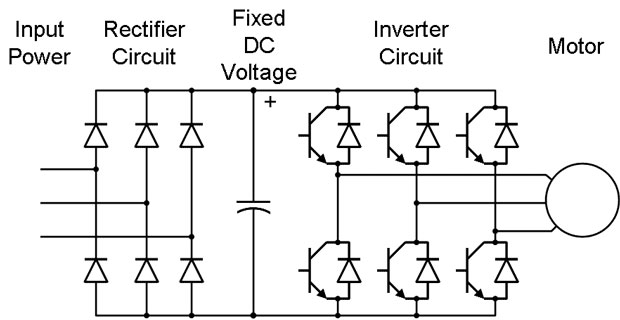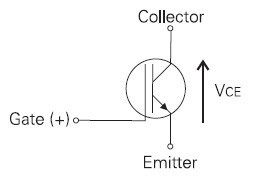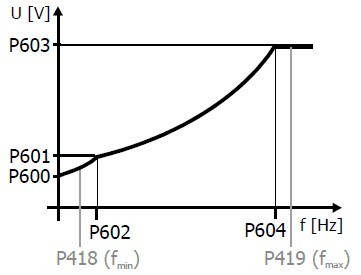VFD Cooling and Ventilation
This paper is intended to be a guide for the installation of VFDs to ensure adequate cooling or ventilation is provided. All power electronic equipment will dissipate heat which must be removed to prevent overheating of the semiconductor devices or other components. The installation and environmental factors must be considered with all external sources of heat removed or minimized. An important consideration is the effects of direct sunlight, in which all precautions should be taken to remove the effects by providing adequate shelter.
The scope of this technical note is to provide guidance to calculate ventilation / cooling requirements of variable frequency drives, but the calculations make no consideration for external factors such as direct sunlight, other heat sources etc.
All Power electronic equipment generates heat during operation which must be removed to maintain the equipment operating temperature below its rated value. The first step is to calculate how much heat the equipment generates. This is dependent upon the type of equipment and how it is configured and operated.
I: VFDs Heat Dissipation
The thermal losses of the VFD may for all practical purposes be assumed to be about 3%. Smaller VFDs are approximately 4% and as the VFD increases in size the percentage of thermal losses decreases to about 3%.
Auxiliary Equipment
Where additional equipment is mounted in the same enclosure as the VFD, any heat generated by such auxiliary equipment must be added to the total heat generated. Equipment suppliers can provide details of the heat generated by their equipment.
Installation alternatives
VFDs are available in different types of enclosures like most electrical equipment to suit the environment which they are to be installed. The type of enclosure supplied is based on the level of protection offered against water and objects, known as an IP rating. If the protection offered is not adequate for the environment to be installed then the alternatives need to be investigated.
These alternatives may include;
1) Use a product with higher protection rating.
Gozuk VFDs are available in IP30, IP66 and also Stainless Steel IP66 which means they may be installed without further protection.
2) Relocate to alternative location.
This is sometimes necessary when the environment may be extremely corrosive or flammable.
3) Install equipment in an enclosure with a higher protection rating.
When equipment that generates heat is installed into another enclosure the heat must be dissipated. If this heat is not removed the heat inside will build up to a level which will affect the reliable operation of the equipment, reduce the life expectancy of the product or cause failure to other equipment. If choosing to ventilate an enclosure this may reduce the protection rating to an unacceptable level.
II: VFD Enclosure Dissipation / Ventilation
Dissipation of Heat Generated inside an Enclosure
The heat generated within an enclosure may be dissipated by:
Non Ventilated Enclosure
Non ventilated enclosures rely on the heat being dissipated through the walls of the enclosure. The better heat conduction of the enclosure the more heat dissipated. For this reason metal enclosures are far better at dissipating heat than plastic enclosures.
The power that can be dissipated in a given exposed surface area is:
PESA = k x S x △T
PESA: Power dissipated from within the enclosure via exposed surface area in W (Watts)
k: Heat transfer coefficient [sheet metal ~ 5.5W/m2K, plastic ~ 3.5W/m2K ]
S: Corrected enclosure surface area of the enclosure, in m2 in accordance with IEC890.
△T: Temperature differential (inside enclosure - outside ambient), in °C
Ventilated Enclosure
With ventilated enclosure the heat is dissipated by forcing ambient air in or out of the enclosure. The objective is to circulate the air through the enclosure, so it is not critical whether the fan creates a pressure or vacuum in the enclosure (ie blows in or out). Generally ambient air is drawn in at the bottom of the cabinet through and discharged through a ventilation opening at the top. The outlet should be placed above the highest mounted VFD.
Filters installed on Fan units provide a better protection rating (normally max IP54) but impede the flow of air. It is important to check the manufacturers specifications when a filter is fitted. Additionally, if the filter collects any dust the airflow will be reduced significantly and needs to be considered in your selection decision and design.
The volume of air required can be estimated using the formula:
V = (3.1 x PEXHAUST) / △T
V: Volume of air flow required, in m3/hr
PEXHAUST: Power exhausted from within the enclosure, in W (Watts)
△T: Temperature differential (inside enclosure - outside ambient), in °C
III: Other Considerations
Equipment Spacing
To adequately exhaust heat generated, certain minimum clearances must be maintained around the variable frequency drive. Please refer to the VFD installation manual for details.
Equipment / stirring Fans
Stirring fans can distribute the heat evenly throughout the enclosure to avoid hot spots. Fans can be controlled to run for a given time at starting or temperature controlled to extend fan life and reduce audible noise.
Forced Ventilation
Where ventilation is used to exhaust heat, care should be taken with regard to IP rating of the enclosure. Furthermore the size of the air intake should be at least the size of the exit and if more than one fan is used then the fans should be the same. Remember where filters are used you must take into account pressure drops across the filters. Filters should be inspected regularly for blockage as part of the maintenance schedule to ensure free air flow and correct operation. Force ventilation may also be temperature controlled to minimize running time and increase the life expectancy of the fans.
Equipment De-rating
The components of electronic equipment are designed to operate under full load at a particular maximum temperature. By reducing the load, the internal operating temperature will be reduced allowing the equipment to operate in a higher ambient temperature. Please refer to the instruction manual or contact your local representative for manufacture derating.
Solar Heating
Exposure of the enclosure to the sunlight (direct or reflected) will result in solar heating. Proper use of a shelter will reduce such heating; and enclosure material and paint colors have different absorption properties of solar energy. VFDs should not be mounted in direct sunlight or on hot surfaces.
Environment
The environment of a VFD installation determines the type of enclosure to be used. Where dust and water (or moisture) are present one may consider using an IP66 enclosure which would then rely entirely on radiated heat loss for cooling or a heat exchanger will be needed. For aggressive environments one may use a stainless steel or plastic enclosure. If a fan or fan/filter is installed the IP66 rating will be degraded.
All the heat loss is taken care of and can be directly mounted on a wall (see instruction manual for further information). The variable frequency drive has an integral dual compartment heat exchanger where the variable frequency drive electronic components are housed in a totally enclosed compartment, and the heat from the variable frequency drive is ventilated in a separate compartment housing the heatsink and ventilation fan (no filters are used). The variable frequency drive can be field mounted closer to the motor thus reducing costs of screened VFD cable.
The scope of this technical note is to provide guidance to calculate ventilation / cooling requirements of variable frequency drives, but the calculations make no consideration for external factors such as direct sunlight, other heat sources etc.
All Power electronic equipment generates heat during operation which must be removed to maintain the equipment operating temperature below its rated value. The first step is to calculate how much heat the equipment generates. This is dependent upon the type of equipment and how it is configured and operated.
I: VFDs Heat Dissipation
The thermal losses of the VFD may for all practical purposes be assumed to be about 3%. Smaller VFDs are approximately 4% and as the VFD increases in size the percentage of thermal losses decreases to about 3%.
Example:
What is the estimated heat generated by a 40A variable frequency drive controlling a 22kW motor at full load?
PLOSS = 22kW x 0.03
= 0.66kW
= 660W
Auxiliary Equipment
Where additional equipment is mounted in the same enclosure as the VFD, any heat generated by such auxiliary equipment must be added to the total heat generated. Equipment suppliers can provide details of the heat generated by their equipment.
Installation alternatives
VFDs are available in different types of enclosures like most electrical equipment to suit the environment which they are to be installed. The type of enclosure supplied is based on the level of protection offered against water and objects, known as an IP rating. If the protection offered is not adequate for the environment to be installed then the alternatives need to be investigated.
These alternatives may include;
1) Use a product with higher protection rating.
Gozuk VFDs are available in IP30, IP66 and also Stainless Steel IP66 which means they may be installed without further protection.
2) Relocate to alternative location.
This is sometimes necessary when the environment may be extremely corrosive or flammable.
3) Install equipment in an enclosure with a higher protection rating.
When equipment that generates heat is installed into another enclosure the heat must be dissipated. If this heat is not removed the heat inside will build up to a level which will affect the reliable operation of the equipment, reduce the life expectancy of the product or cause failure to other equipment. If choosing to ventilate an enclosure this may reduce the protection rating to an unacceptable level.
II: VFD Enclosure Dissipation / Ventilation
Dissipation of Heat Generated inside an Enclosure
The heat generated within an enclosure may be dissipated by:
- The enclosure wall surface area (ie. non ventilated)
- Forced air ventilation
- Heat exchanger or water cooling (not dealt with in this article)
Non Ventilated Enclosure
Non ventilated enclosures rely on the heat being dissipated through the walls of the enclosure. The better heat conduction of the enclosure the more heat dissipated. For this reason metal enclosures are far better at dissipating heat than plastic enclosures.
The power that can be dissipated in a given exposed surface area is:
PESA = k x S x △T
PESA: Power dissipated from within the enclosure via exposed surface area in W (Watts)
k: Heat transfer coefficient [sheet metal ~ 5.5W/m2K, plastic ~ 3.5W/m2K ]
S: Corrected enclosure surface area of the enclosure, in m2 in accordance with IEC890.
△T: Temperature differential (inside enclosure - outside ambient), in °C
Ventilated Enclosure
With ventilated enclosure the heat is dissipated by forcing ambient air in or out of the enclosure. The objective is to circulate the air through the enclosure, so it is not critical whether the fan creates a pressure or vacuum in the enclosure (ie blows in or out). Generally ambient air is drawn in at the bottom of the cabinet through and discharged through a ventilation opening at the top. The outlet should be placed above the highest mounted VFD.
Filters installed on Fan units provide a better protection rating (normally max IP54) but impede the flow of air. It is important to check the manufacturers specifications when a filter is fitted. Additionally, if the filter collects any dust the airflow will be reduced significantly and needs to be considered in your selection decision and design.
The volume of air required can be estimated using the formula:
V = (3.1 x PEXHAUST) / △T
V: Volume of air flow required, in m3/hr
PEXHAUST: Power exhausted from within the enclosure, in W (Watts)
△T: Temperature differential (inside enclosure - outside ambient), in °C
III: Other Considerations
Equipment Spacing
To adequately exhaust heat generated, certain minimum clearances must be maintained around the variable frequency drive. Please refer to the VFD installation manual for details.
Equipment / stirring Fans
Stirring fans can distribute the heat evenly throughout the enclosure to avoid hot spots. Fans can be controlled to run for a given time at starting or temperature controlled to extend fan life and reduce audible noise.
Forced Ventilation
Where ventilation is used to exhaust heat, care should be taken with regard to IP rating of the enclosure. Furthermore the size of the air intake should be at least the size of the exit and if more than one fan is used then the fans should be the same. Remember where filters are used you must take into account pressure drops across the filters. Filters should be inspected regularly for blockage as part of the maintenance schedule to ensure free air flow and correct operation. Force ventilation may also be temperature controlled to minimize running time and increase the life expectancy of the fans.
Equipment De-rating
The components of electronic equipment are designed to operate under full load at a particular maximum temperature. By reducing the load, the internal operating temperature will be reduced allowing the equipment to operate in a higher ambient temperature. Please refer to the instruction manual or contact your local representative for manufacture derating.
Solar Heating
Exposure of the enclosure to the sunlight (direct or reflected) will result in solar heating. Proper use of a shelter will reduce such heating; and enclosure material and paint colors have different absorption properties of solar energy. VFDs should not be mounted in direct sunlight or on hot surfaces.
Environment
The environment of a VFD installation determines the type of enclosure to be used. Where dust and water (or moisture) are present one may consider using an IP66 enclosure which would then rely entirely on radiated heat loss for cooling or a heat exchanger will be needed. For aggressive environments one may use a stainless steel or plastic enclosure. If a fan or fan/filter is installed the IP66 rating will be degraded.
All the heat loss is taken care of and can be directly mounted on a wall (see instruction manual for further information). The variable frequency drive has an integral dual compartment heat exchanger where the variable frequency drive electronic components are housed in a totally enclosed compartment, and the heat from the variable frequency drive is ventilated in a separate compartment housing the heatsink and ventilation fan (no filters are used). The variable frequency drive can be field mounted closer to the motor thus reducing costs of screened VFD cable.
Post a Comment:
You may also like:
Featured Articles
What is VFD, How it works? - VFD ...
 VFD is shorted for Variable Frequency Drive (also known as AC Drives and Inverters) -- that's used to make an AC motor working in ...
VFD is shorted for Variable Frequency Drive (also known as AC Drives and Inverters) -- that's used to make an AC motor working in ...
 VFD is shorted for Variable Frequency Drive (also known as AC Drives and Inverters) -- that's used to make an AC motor working in ...
VFD is shorted for Variable Frequency Drive (also known as AC Drives and Inverters) -- that's used to make an AC motor working in ...VFD: Insulated Gate Bipolar Transistor ...
 IGBT (insulated gate bipolar transistor) provides a high switching speed necessary for PWM VFD operation. IGBTs are capable of ...
IGBT (insulated gate bipolar transistor) provides a high switching speed necessary for PWM VFD operation. IGBTs are capable of ...
 IGBT (insulated gate bipolar transistor) provides a high switching speed necessary for PWM VFD operation. IGBTs are capable of ...
IGBT (insulated gate bipolar transistor) provides a high switching speed necessary for PWM VFD operation. IGBTs are capable of ...Three phase inverters
 In the variable frequency drive rectifier paper, it explains how to go from three phase alternating current voltage to a direct ...
In the variable frequency drive rectifier paper, it explains how to go from three phase alternating current voltage to a direct ...
 In the variable frequency drive rectifier paper, it explains how to go from three phase alternating current voltage to a direct ...
In the variable frequency drive rectifier paper, it explains how to go from three phase alternating current voltage to a direct ...Variable Frequency Drive Harmonics and ...
A discussion of the benefits of variable frequency drives often leads to a question regarding electrical harmonic distortion ...
Variable frequency drive Energy saving
 Energy can be saved in a VFD by reducing the losses in the electric motor or by reducing the energy consumption of the variable ...
Energy can be saved in a VFD by reducing the losses in the electric motor or by reducing the energy consumption of the variable ...
 Energy can be saved in a VFD by reducing the losses in the electric motor or by reducing the energy consumption of the variable ...
Energy can be saved in a VFD by reducing the losses in the electric motor or by reducing the energy consumption of the variable ...
VFD manufacturers
